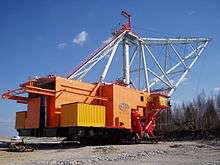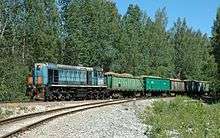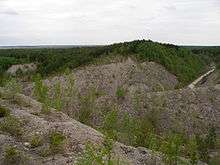Enefit Kaevandused
Enefit Kaevandused (former names: Eesti Põlevkivi and Eesti Energia Kaevandused) is a mining company located in Jõhvi, Estonia. It is a subsidiary of Eesti Energia, an Estonian state-owned energy company. The core activity of Enefit Kaevandused is oil-shale mining. The produced oil shale is mainly used to fuel oil shale-fired power stations in the north–east of Estonia.[1] The company has 3,150 employees.[2] The chief executive officer is Andres Vainola.[3]
| subsidiary of Eesti Energia | |
| Industry | Mining |
| Founded | 1945 |
| Headquarters | , |
Area served | North–east Estonia |
Key people | Andres Vainola (CEO) |
| Products | Oil shale |
Number of employees | 3,150 (2009) |
| Parent | Eesti Energia |
History
Enefit Kaevandused were established in June 1945 as Eesti Põlevkivi, also known by its name in Russian Estonslanets. It was created by merging Kukruse and Käva II mines. In 1946, it took over Viivikonna mine.[4]
New mines were opened in Ahtme (1948), Jõhvi (No. 2, 1949), Sompa (1949), Tammiku (1951), and in the area between Käva and Sompa (No. 4, 1953).[5] The Ubja mine was given to Eesti Põlevkivi in 1957, but it was closed in 1959.[6] After construction of large oil shale-fired power stations in Narva, demand for oil shale increased and consequently Eesti Põlevkivi opened the underground mines Viru (1965) and Estonia (1972) along with the open-pit mines Sirgala (1963), Narva (1970) and Oktoobri (1974; later named Aidu).[5] Correspondingly, several exhausted smaller mines like Kukruse (1967), Käva (1972), No. 2 (1973), No. 4 (1975), and Kiviõli (1987) were closed.[5][7] The Estonia Mine became the largest oil shale mine in the world.[8] At the end of 1988, a fire broke out in the Estonia Mine. The largest underground fire in Estonia, it continued for 81 days and caused serious pollution of ground and surface waters.[9]
In 1998, Eesti Põlevkivi and Dynamit Nobel opened an explosives manufacturing plant in Estonia.[10] After Dynamit Nobel sold its explosives business to Orica, the later became the main shareholder in the plant.
Due to a decrease in demand, the Tammiku and Sompa mines closed in 1999 and those at Kohtla and Ahtme closed in 2001.[7] In 2000, the open-pit mines at Viivikonna, Sirgala and Narva were merged into the single Narva open-pit mine.[11] The exhausted Aidu open-pit mine was closed in 2012, followed a year later by the Viru underground mine.[12][13]
In 1999, Government of Estonia handed 51% of shares of Eesti Põlevkivi to Narva Elektrijaamad.[14] In 2003, Government transferred remained 49% stake in Eesti Põlevkivi to Eesti Energia. Also Narva Elektrijaamad-owned 51% stake was transferred to Eesti Energia and Eesti Põlevkivi became a fully owned subsidiary of Eesti Energia.[15]
Operations
Enefit Kaevandused operates the Estonia Underground Mine and the Narva Open-Cast Mine. In addition, it owns minority stake 35% in the manufacturer of explosives Orica Eesti OÜ, a subsidiary of Orica.
Gallery
 Dragline excavator in Narva mine.
Dragline excavator in Narva mine. Company's train transporting oil-shale near Ahtme.
Company's train transporting oil-shale near Ahtme. Unrehabilitated land in older part of Aidu mine.
Unrehabilitated land in older part of Aidu mine.
See also
References
- Tere, Juhan (2010-02-05). "Estonian oil shale mining industry posted record of a decade due to cold weather in January". The Baltic Course. Retrieved 2010-04-03.
- Tere, Juhan (2009-10-06). "Eesti Energia Kaevandused makes 49 employees redundant". The Baltic Course. Retrieved 2010-04-03.
- Gamzejev, Erik (2019-04-15). "Andres Vainola naaseb kaevanduste etteotsa kulusid kokku tõmbama" [Andres Vainola returns to the front of the mines to cut costs]. Põhjarannik (in Estonian). Retrieved 2019-04-28.
- Pihlamägi, Maie (2010). "Policy of transition: Industry in the Estonian SSR during the first post-war five-year plan (1946–1950)" (PDF). Acta Historica Tallinnensia. Estonian Academy Publishers. 15: 146–166. doi:10.3176/hist.2010.1.07. Retrieved 2014-08-21.
- Kattai, V.; Lokk, U. (1998). "Historical review of the kukersite oil shale exploration in Estonia". Oil Shale. A Scientific-Technical Journal. Estonian Academy Publishers. 15 (2S): 102–110. Retrieved 2008-11-23.
- Saarnak et al. (2014), p. 66
- Karu, Veiko; Valgma, Ingo; Kolats, Margit (2013). "Mine water as a potential source of energy from underground mined area in Estonian oil shale deposit" (PDF). Oil Shale. A Scientific-Technical Journal. 30 (2S): 336–362. doi:10.3176/oil.2013.2S.12. ISSN 0208-189X. Retrieved 2014-04-12.
- Koppel, Karin (2012-04-11). "Estonia põlevkivikaevandus tähistab 40. sünnipäeva" [Estonia oil shale mine celebrates 40th anniversary] (in Estonian). ERR. Archived from the original on 2014-12-03. Retrieved 2014-12-03.
- Parakhonsky, E. (1995). "Особенности развития, тушения и ликвидации последствий подземных пожаров ха сланцевых шахтах" [Underground fires in oil shale mines: special traits of their spreading, extinguishing and liquidating of consequences]. Oil Shale. A Scientific-Technical Journal (in Russian). 12 (1): 63–77. ISSN 0208-189X.
- Soolep, Argo (1998-01-17). "Ida-Virumaal hakkas tööle lõhkeaineteha" [An explosives manufacturing plant starts working in Ida-Virumaa]. Postimees (in Estonian). Retrieved 2019-03-18.
- Sepp, Mait (2009). "Põlevkivisaaga Narva karjääri maadel" [The oil shale saga on the lands of Narva open-pit mine]. Eesti Loodus (in Estonian) (6). Archived from the original on 2014-04-13. Retrieved 2014-04-12.
- "Mining waste turned to good use". Baltic Times. 2013-04-25. Archived from the original on 2014-11-10. Retrieved 2014-04-12.
- "Viru Mine to Close with 200 Jobs Lost". ERR. 2013-05-31. Archived from the original on 2014-11-10. Retrieved 2014-04-12.
- "Estonian government allocates energy shares ahead of privatization". ETA. 1999-06-02. (subscription required). Retrieved 2013-01-19.
- "Estonia industry: Government to give Eesti Energia stake in Eesti Polevkivi". Economist Intelligence Unit. 2003-01-17. (subscription required). Archived from the original on 2014-12-09. Retrieved 2013-01-19.
Bibliography
- Saarnak, Martin; Uibopuu, Lembit; Valgma, Ingo; Nurme, Martin; Väizene, Vivika (2014). "6. Eesti põlevkivi kaevandamisviisid" [6. Mining methods of Estonian oil shale] (PDF). In Valgma, Ingo (ed.). Mäendus [Mining] (in Estonian). Institute of Mining. Tallinn University of Technology. pp. 55–68. ISBN 978-9949-430-80-2.